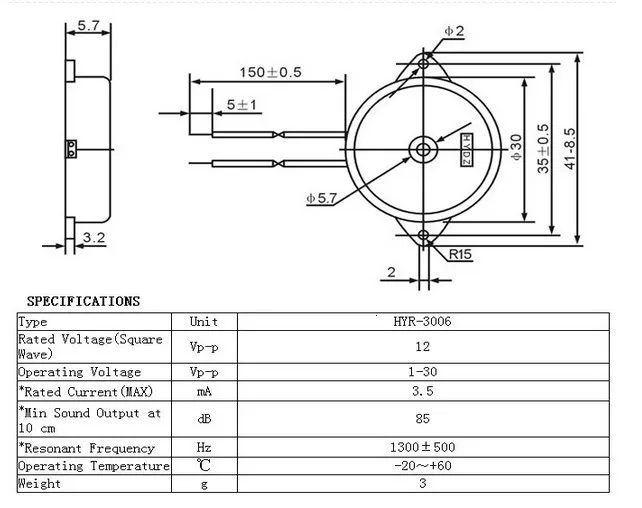
- Stock: In Stock
- Product Code: BBZ005.ACT5
- Weight: 4.10
3 - 12V Buzzer Passive with Wire AT3040
The AT3040 is a model of passive buzzer commonly used in various electronic applications for generating sound alerts. Here are the detailed specifications and typical usage scenarios for the AT3040 passive buzzer:
Key Features:
- No Built-in Oscillator: As a passive buzzer, the AT3040 requires an external signal (such as a PWM signal) to produce sound. It does not have an internal oscillating circuit.
- Wide Frequency Range: Capable of producing a wide range of frequencies depending on the input signal.
- Compact Size: Generally has a small form factor, making it suitable for use in compact electronic devices.
- Low Power Consumption: Operates efficiently with low power consumption.
Technical Specifications:
- Model: AT3040
- Type: Passive buzzer
- Dimensions: Typically 12mm in diameter
- Operating Voltage: Commonly operates at 3V to 12V DC (peak voltage 30V)
- Frequency Range: Can operate within a range of frequencies, usually specified by the external driving circuit (commonly between 1kHz and 5kHz)
- Sound Pressure Level: Approximately 85 dB @ 10cm (this can vary based on the driving signal and voltage)
- Current Consumption: Typically around 10-30 mA, depending on the input signal

Applications:
- Electronic Projects: Widely used in Arduino and other microcontroller-based projects for generating alerts and sounds.
- Alarm Systems: Utilized in security systems to produce alert sounds.
- Home Appliances: Integrated into devices like washing machines, microwaves, and other appliances to provide status or alert sounds.
- Toys and Gadgets: Employed in toys and electronic gadgets for sound effects and music.
Advantages:
- Versatile Sound Production: Capable of producing a variety of sounds, tones, and frequencies depending on the input signal.
- Cost-Effective: Generally inexpensive and easy to source.
- Compact and Lightweight: Small form factor makes it suitable for various compact applications.
Disadvantages:
- Requires External Signal: Needs an external signal generator or microcontroller to produce sound, which can complicate circuit design.
- Dependent on Input Signal: The quality and volume of the sound are directly influenced by the characteristics of the input signal.
Example Usage with Arduino:
To use the AT3040 passive buzzer with an Arduino, you can connect it to a PWM-capable pin and use the tone() function to generate sound. Here is an example:
int buzzerPin = 9; // Connect the buzzer to pin 9void setup() { pinMode(buzzerPin, OUTPUT);}void loop() { tone(buzzerPin, 1000); // Generate a 1kHz tone delay(1000); // Wait for 1 second noTone(buzzerPin); // Stop the tone delay(1000); // Wait for 1 second}
The AT3040 passive buzzer is a versatile and cost-effective component used for generating sound in a variety of electronic applications. It requires an external oscillating signal to produce sound, which allows it to generate a wide range of frequencies and tones. This makes it suitable for use in projects, alarm systems, home appliances, and toys. Its compact size and low power consumption add to its suitability for many applications, although the need for an external signal can add complexity to the circuit design.






